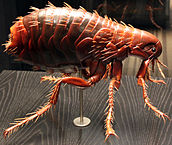
“2013 Naturkundemuseum Berlin pulex irritans anagoria” by Anagoria – Own work. Licensed under CC BY 3.0 via Wikimedia Commons.
Fleas belong to the order syphonaptera, they vary in size from 1 mm such as the rabbit flea to the mole flea that can be up to 8 mm.
Fleas vary from a light brown in color to nearly black although most encountered by DEAD EFFICIENT PEST CONTROL are a reddish brown. They are flattened from side to side in appearance allowing them to move easily through hair and fur and are covered in backward facing bristles. They have well developed muscles in the hind limbs and a unique skeletal structure which are special designs for jumping. Fleas have no wings, reduced or no compound eyes and piercing and sucking mouth parts.
Adult fleas live as parasites on warm blooded animals and although they show host preferences they will feed on sources of blood in the absence of their normal host. Some species are unable to breed without the presence of the blood from their definitive host.
Life cycle
A single female is capable of producing several hundred eggs during her lifespan. The eggs hatch after a week and the legless, white, threadlike larvae feed on organic waste including undigested blood and excreta left by adults. The larvae are about 1.5 mm long at this stage and are identified by their eyeless brown head, biting jaws, 3 segmented thorax and 10 segmented abdomen covered in bristles with peg like protrusions on the final segment.
The larvae become grey in color as they grow and after 2 – 3 weeks, having moulted twice, reach a length of about 5mm. At this stage they begin to spin silken cocoons in which they pupate.
These cocoons are tent shaped and incorporate dust particles etc which help to camouflage the pupa and makes them difficult to penetrate with a water based insecticide. This is a major problem in unoccupied properties and the use of an oil based insecticide is recommended for these areas or the use of a desiccant dust in the joints of floorboards and skirting boards. The young turn brown as they develop into adults and are capable of remaining dormant for 8 months until stimulated to emerge for a feed. It is known that fleas breed close to their hosts in dust, sweepings, diet, cracks and crevices and general rubbish. The whole cycle from egg to adult takes about a month in summer, much longer at lower temperatures. When unoccupied premises need to be treated workmen can be protected from bites by wearing over-boots that have been treated with a repellent.
Nuisance factor
Fleas will often go unnoticed until towards August and September, either people are bitten or pets begin to suffer. When hungry fleas will jump onto people (not their preferred host) feed a little on blood then jump off again to await a more suitable host.
Bites to humans can cause intense reddened irritation around a red spot that can last up to 2 days. First bites are not usually responsible for serious reactions although subsequent ones may lead to hypersensitivity in some people.
It is thought that up to 50% of all skin diseases suffered by cats and dogs are caused by allergic reactions to flea bites which attack all pets at one time or another in their lifetime.
Fleas are capable of spreading serious disease. The most critical of these being the infectious bubonic plague. The flea also carries a variety of other diseases too numerous to mention.
While the spread of disease is still prevalent it is also the case that fleas are a cause of irritation and social stigma.
Control
Despite the natural misfortunes common to all creatures living in uncontrolled conditions such as predators, parasites, diseases and extremes of temperatures, fleas continue to be a pest and their control remains necessary.
Flea control is best directed at the free living stages when the flea is not on the host. Effective flea control means halting the flea life cycle rather than just treating the adult.
The correct flea control measures can only be decided when the level of infestation has been determined. In many cases infestations (even of spotlessly clean homes) can be attributed to pets, who may well have picked up the fleas from outside sources.
Before applying any treatment floors and furniture must be thoroughly cleaned and vacuumed. Particular attention should be given to pets bedding areas and places they frequent the most. Pest should be treated appropriately and infested bedding should be thrown away.
Thoroughness is vital when treating any flea infestations as problems can quickly resurface if not treated sufficiently.
Of course the easiest way to get rid of a flea problem is call DEAD EFFICIENT PEST CONTROL

